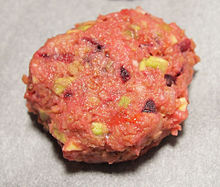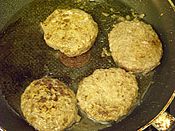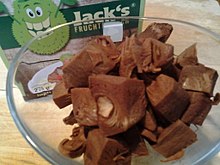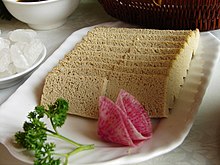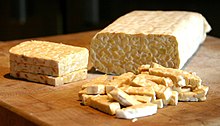
Buddhist cuisine is an Asian cuisine that is followed by monks and many believers from areas historically influenced by Mahayana Buddhism. It is vegetarian or vegan, and it is based on the Dharmic concept of ahimsa (non-violence). Vegetarianism is common in other Dharmic faiths such as Hinduism, Jainism and Sikhism, as well as East Asian religions like Taoism. While monks, nuns and a minority of believers are vegetarian year-round, many believers follow the Buddhist vegetarian diet for celebrations.
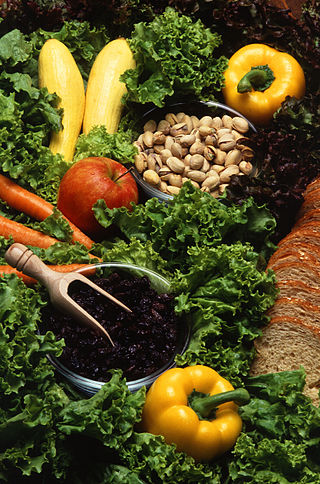
Vegetarian cuisine is based on food that meets vegetarian standards by not including meat and animal tissue products.

Seitan is a food made from gluten, the main protein of wheat. It is also known as miànjīn, fu, milgogi, wheat meat, gluten meat, vital wheat gluten or simply gluten. It is made by washing wheat flour dough with water until most of the starch granules have been removed, leaving behind the sticky, insoluble gluten as an elastic mass, which is then cooked and eaten.

Textured or texturized vegetable protein (TVP), also known as textured soy protein (TSP), soy meat, or soya chunks is a defatted soy flour product, a by-product of extracting soybean oil. It is often used as a meat analogue or meat extender. It is quick to cook, with a protein content comparable to some meats.

Tempeh or tempe is a traditional Indonesian food made from fermented soybeans. It is made by a natural culturing and controlled fermentation process that binds soybeans into a cake form. A fungus, Rhizopus oligosporus or Rhizopus oryzae, is used in the fermentation process and is also known as tempeh starter.

A meat alternative or meat substitute, is a food product made from vegetarian or vegan ingredients, eaten as a replacement for meat. Meat alternatives typically approximate qualities of specific types of meat, such as mouthfeel, flavor, appearance, or chemical characteristics. Plant- and fungus-based substitutes are frequently made with soy, but may also be made from wheat gluten as in seitan, pea protein as in the Beyond Burger, or mycoprotein as in Quorn.

Tofurkey is a plant-based meat substitute patterned after turkey, in the form of a loaf of vegetarian protein, usually made from tofu or seitan with a stuffing made from grains or bread, flavored with a broth and seasoned with herbs and spices. It is often served at a vegetarian or vegan Thanksgiving meal.

Mock duck is a gluten-based meat substitute. It is made of wheat gluten, oil, sugar, soy sauce, and salt, and is high in protein. Its distinctive flavor and artificial "plucked duck" texture distinguish it from other forms of commercially available gluten products. Mock duck is not meant to be eaten raw and needs to be prepared, usually by lightly frying in vegetable oil.

Okara, soy pulp, or tofu dregs is a pulp consisting of insoluble parts of the soybean that remain after pureed soybeans are filtered in the production of soy milk and tofu. It is generally white or yellowish in color. It is part of the traditional cuisines of Japan, Korea, and China. Since the 20th century, it has been used in the vegetarian cuisines of Western nations.

Lightlife Foods is a company that produces food for plant-based diets. In 2018, its worth was estimated at $80 million. It is best known for its plant-based veggie dog, Smart Dog, which launched in 1993. In 2019, the company launched a plant-based burger to compete with Impossible Foods and Beyond Meat. Lightlife Foods is a carbon-neutral company.

Tofurky is the brand name of an American vegan turkey replacement made from a blend of wheat protein and organic tofu. Tofurky brand was officially introduced in 1995.
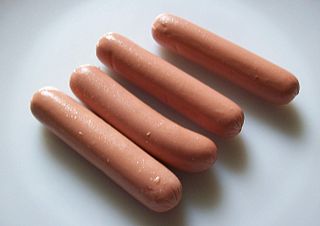
A vegetarian hot dog is a hot dog produced completely from non-meat products. Unlike traditional home-made meat sausages, the casing is not made of intestine, but of cellulose or other plant-based ingredients. The filling is usually based on some sort of soy protein, wheat gluten, or pea protein. Some may contain egg whites, which would make them unsuitable for a lacto-vegetarian or vegan diet.

Javanese cuisine is the cuisine of Javanese people, a major ethnic group in Indonesia, more precisely the province of Central Java, Yogyakarta and East Java.

Tofu is a food prepared by coagulating soy milk and then pressing the resulting curds into solid white blocks of varying softness: silken, soft, firm, extra firm. Tofu is also known as bean curd in English. It is a traditional component of East Asian and Southeast Asian cuisines, and has been consumed in China for over 2,000 years. In modern Western cooking, it is most often treated as a meat substitute.

Vegetarian bacon, also referred to as veggie bacon, vegan bacon, vegan rashers, vacon, or facon, is a plant-based version of bacon.

Sundanese cuisine is the cuisine of the Sundanese people of Western Java, and Banten, Indonesia. It is one of the most popular foods in Indonesia. Sundanese food is characterised by its freshness; the famous lalab eaten with sambal and also karedok demonstrate the Sundanese fondness for fresh raw vegetables. Unlike the rich and spicy taste, infused with coconut milk and curry of Minangkabau cuisine, the Sundanese cuisine displays the simple and clear taste; ranged from savoury salty, fresh sourness, mild sweetness, to hot and spicy.

Tauge goreng is an Indonesian savoury vegetarian dish made of stir-fried tauge with slices of tofu, ketupat or lontong rice cake and yellow noodles, served in a spicy oncom-based sauce. Tauge goreng is a specialty of Jakarta and Bogor city, West Java, Indonesia. It is usually sold as street food using pikulan or gerobak (cart) by street vendors. It is a popular street food in Indonesia, especially in Jakarta, and Greater Jakarta areas, including Bogor, Depok, Tangerang and Bekasi.

A tempeh burger is a vegetarian hamburger variant with tempeh—Indonesian fermented soybean cakes, as main ingredient.
